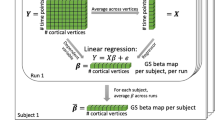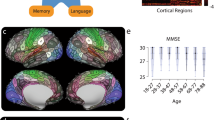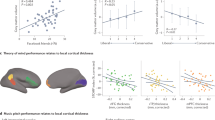Abstract
We investigated the relationship between individual subjects' functional connectomes and 280 behavioral and demographic measures in a single holistic multivariate analysis relating imaging to non-imaging data from 461 subjects in the Human Connectome Project. We identified one strong mode of population co-variation: subjects were predominantly spread along a single 'positive-negative' axis linking lifestyle, demographic and psychometric measures to each other and to a specific pattern of brain connectivity.
This is a preview of subscription content, access via your institution
Access options
Subscribe to this journal
Receive 12 print issues and online access
$209.00 per year
only $17.42 per issue
Buy this article
- Purchase on Springer Link
- Instant access to full article PDF
Prices may be subject to local taxes which are calculated during checkout


Similar content being viewed by others
References
Van Essen, D.C. et al. Neuroimage 80, 62–79 (2013).
Beckmann, C.F. & Smith, S.M. IEEE Trans. Med. Imaging 23, 137–152 (2004).
Hotelling, H. Biometrika 28, 321–377 (1936).
Winkler, A. et al. Neuroimage published online, 10.1016/j.neuroimage.2015.05.092 (11 June 2015).
Spearman, C. Am. J. Psychol. 15, 201–292 (1904).
Fox, M.D. et al. Proc. Natl. Acad. Sci. USA 102, 9673–9678 (2005).
Binder, J.R. et al. Cereb. Cortex 19, 2767–2796 (2009).
Schacter, D.L. et al. Neuron 76, 677–694 (2012).
Clithero, J.A. & Rangel, A. Soc. Cogn. Affect. Neurosci. 9, 1289–1302 (2014).
Kable, J.W. & Glimcher, P.W. Nat. Neurosci. 10, 1625–1633 (2007).
Doeller, C.F. et al. Nature 463, 657–661 (2010).
Saxe, R. et al. Annu. Rev. Psychol. 55, 87–124 (2004).
Poldrack, R.A. Trends Cogn. Sci. 10, 59–63 (2006).
Cole, M.W. et al. J. Neurosci. 32, 8988–8999 (2012).
Woolgar, A. et al. Proc. Natl. Acad. Sci. USA 107, 14899–14902 (2010).
Thomson, G.H. Br. J. Psychol. 8, 271–281 (1916).
Harrison, S.J. et al. Neuroimage 109, 217–231 (2015).
Ugˇurbil, K. et al. Neuroimage 80, 80–104 (2013).
Jenkinson, M. et al. Neuroimage 62, 782–790 (2012).
Fischl, B. et al. Neuroimage 9, 195–207 (1999).
Marcus, D.S. et al. Neuroimage 80, 202–219 (2013).
Smith, S.M. et al. Neuroimage 80, 144–168 (2013).
Glasser, M.F. et al. Neuroimage 80, 105–124 (2013).
Salimi-Khorshidi, G. et al. Neuroimage 90, 449–468 (2014).
Griffanti, L. et al. Neuroimage 95, 232–247 (2014).
Smith, S.M. et al. Neuroimage 101, 738–749 (2014).
Filippini, N. et al. Proc. Natl. Acad. Sci. USA 106, 7209–7214 (2009).
Marrelec, G. et al. Neuroimage 32, 228–237 (2006).
Van der Waerden, B.L. Proc. K. Ned. Akad. Wet. A. 55, 453–458 (1952).
Acknowledgements
We thank our many colleagues in the WU-Minn HCP Consortium for their invaluable contributions in generating the publicly available HCP data and implementing the procedures needed to acquire, analyze, visualize and share these data sets. We are grateful for funding from the US National Institutes of Health (grants 1U54MH091657, P30-NS057091, P41-RR08079/EB015894 and F30-MH097312) and the Wellcome Trust (grants 098369/Z/12/Z and 091509/Z/10/Z).
Author information
Authors and Affiliations
Contributions
D.V.E., K.U., D.B., T.B., M.G. and S.S. contributed to the data acquisition and image processing. S.S., K.M., T.N., D.V., A.W. and T.B. designed and carried out the statistical analyses. All of the authors contributed to writing the paper.
Corresponding author
Ethics declarations
Competing interests
The authors declare no competing financial interests.
Supplementary information
Supplementary Text and Figures
Supplementary Figures 1–4 and Supplementary Tables 1 and 2 (PDF 4287 kb)
Rights and permissions
About this article
Cite this article
Smith, S., Nichols, T., Vidaurre, D. et al. A positive-negative mode of population covariation links brain connectivity, demographics and behavior. Nat Neurosci 18, 1565–1567 (2015). https://doi.org/10.1038/nn.4125
Received:
Accepted:
Published:
Issue Date:
DOI: https://doi.org/10.1038/nn.4125
This article is cited by
-
Nuclei-specific hypothalamus networks predict a dimensional marker of stress in humans
Nature Communications (2024)
-
Limited generalizability of multivariate brain-based dimensions of child psychiatric symptoms
Communications Psychology (2024)
-
Multivariate patterns of brain functional connectome associated with COVID-19-related negative affect symptoms
Translational Psychiatry (2024)
-
Inter-individual, hemispheric and sex variability of brain activations during numerosity processing
Brain Structure and Function (2024)
-
Heterogeneous factors influence social cognition across diverse settings in brain health and age-related diseases
Nature Mental Health (2024)



